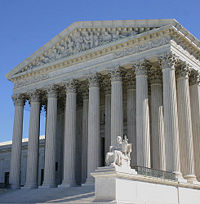Supreme Court of the United States: Difference between revisions
imported>Shamira Gelbman (SCOTUS building image) |
imported>Shamira Gelbman m (capitalization) |
||
| Line 2: | Line 2: | ||
{{Image|US Supreme Court Building.jpg|right|200px|The U.S. Supreme Court Building in Washington, D.C.}} | {{Image|US Supreme Court Building.jpg|right|200px|The U.S. Supreme Court Building in Washington, D.C.}} | ||
The '''Supreme Court of the United States of America''' is the highest federal court in the [[United States]]. It consists of nine | The '''Supreme Court of the United States of America''' is the highest federal court in the [[United States]]. It consists of nine justices, including a [[Chief Justice of the United States|Chief Justice]] and eight [[Associate Justice of the Supreme Court of the United States|associate justices]]. Justices are nominated by the [[President of the United States|President]] and confirmed by the [[U.S. Senate|Senate]]. Article Three of the [[U.S. Constitution]] defines the original and appellate jurisdiction of the Supreme Court, which includes appeals of federal and state cases and trials of cases where a State or foreign ambassador is a party, although the Eleventh Amendment somewhat limits the jurisdiction of federal courts. There is no constitutional specification of how many justices make up the Court, and Congress increased the number as the nation grew. | ||
==The current Court== | ==The current Court== | ||
Revision as of 00:13, 17 May 2009
The Supreme Court of the United States of America is the highest federal court in the United States. It consists of nine justices, including a Chief Justice and eight associate justices. Justices are nominated by the President and confirmed by the Senate. Article Three of the U.S. Constitution defines the original and appellate jurisdiction of the Supreme Court, which includes appeals of federal and state cases and trials of cases where a State or foreign ambassador is a party, although the Eleventh Amendment somewhat limits the jurisdiction of federal courts. There is no constitutional specification of how many justices make up the Court, and Congress increased the number as the nation grew.
The current Court
The current Chief Justice is John G. Roberts, a 53-year-old George W. Bush appointee in September 2005, a Harvard-trained lawyer, former Associate Counsel to the President, and practicing Roman Catholic. The current associate Justices are as follows:
- John Paul Stevens, a Ford appointee in 1975, and the longest serving current member of the court, having served on the Burger Court and the Rehnquist Court. Stevens is also the second oldest Supreme Court Justice in the history of the United States.
- Antonin Scalia, a Reagan appointee in 1986, is a controversial jurist, the most prominent supporter of the concept of originalism and textualism, and Roman Catholic.
- Anthony Kennedy, a 1988 Reagan appointee, is a conservative and libertarian member of the Court, often serving as the swing vote on controversial decisions.
- David Souter, a 1990 George H. W. Bush appointee, has tended towards being more liberal since Planned Parenthood v. Casey. Following the election of President Barack Obama, Justice Souter has announced his retirement from the Supreme Court[1].
- Clarence Thomas, a 1991 George H. W. Bush appointee, is the second African-American to serve on the Supreme Court after Thurgood Marshall, and has a conservative judicial philosophy, adhering to originalism
- Ruth Bader Ginsburg, a 1993 Clinton appointee, is the second woman to serve on the Supreme Court (the first being the recently retired Sandra Day O'Connor)
- Stephen Breyer, a 1994 Clinton appointee, and the leading liberal Justice on the court
- Samuel Alito, a 2006 George W. Bush appointee, a conservative Catholic, nominated after Bush failed to nominate Harriet Miers to the court
